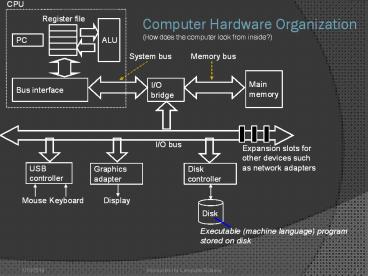Computer Hardware Organization (How does the computer look from inside?) - PowerPoint PPT Presentation
1 / 17
Title:
Computer Hardware Organization (How does the computer look from inside?)
Description:
Title: Introduction to Computer Science week 01 Computing it is all about Problem Solving Author: wadaa Last modified by: schwing Created Date – PowerPoint PPT presentation
Number of Views:602
Avg rating:3.0/5.0
Title: Computer Hardware Organization (How does the computer look from inside?)
1
Computer Hardware Organization(How does the
computer look from inside?)
CPU
Register file
ALU
PC
System bus
Memory bus
Main memory
I/O bridge
Bus interface
I/O bus
Expansion slots for other devices such as network
adapters
USB controller
Disk controller
Graphics adapter
Mouse
Keyboard
Display
Disk
Executable (machine language) program stored on
disk
2
(No Transcript)
3
Computer Hardware Buses
- Electrical conduits connecting computer
components - Transport bytes of information back and forth
between components - Designed to transfer chunks of bytes called words
- The number of bytes in a word (word size) is a
fundamental system parameter - For example, Intel Pentium systems have a word
size of 4 bytes (32 bits)
4
Computer Hardware - I/O devices
- The computer systems connection to the external
world - Examples, Keyboard(I), mouse(I), Screen(I), disk
drive (I and O) - Each I/O device connects to the bus by a
controller or an adaptor. - A Controller is a chip set in the device itself,
or on the systems main board (motherboard) - An Adaptor is a card that plugs into a slot on
the motherboard - Purpose of controller or adaptor is to over see
the transfer bits back an forth the I/O bus and
the I/O device.
5
Computer Hardware Main Memory(MM)
- MM is a temporary storage device (in what way
temporary?) and connection to the external world - Holds both a program and its data which the
program manipulates while the processor is
executing the program - Physically, MM consists of a collection of
Dynamic Random Access Memory (DRAM) chips. - Logically, MM is organized as a linear array of
bytes, each with its own unique address. - The only operations MM understands is to read
(transfer bytes from an address to CPU), or to
write (transfer bytes from the CPU to a given
address)
6
Computer Hardware Processor (CPU)
- The Central Processing Unit (CPU) interprets
instructions stored in MM - Among other things contains the following
- Program Counter (PC), a register that contains
the address the next program instruction. - Registers, a collection of small storage devices
both special and general purpose. - Arithmetic/Logic unit (ALU), computes new data
and address values (think of it as the calculator
of the computer)
7
Computer Hardware Processor (CPU)
8
Computer Hardware CPU Process
- FETCH - Read from MM the instruction (bits) whose
address is in PC register. - DECODE - Interpret the bits in the instruction.
- EXECUTE - Perform some simple operation dictated
by the instruction. - In parallel, update the address in the PC
register to the address of the next instruction.
9
Computer Hardware CPU Instructions
- Load Copy a word from MM into a register.
- Store Copy a word from a register to a location
in MM. - I/O read/write Copy a word between an I/O device
and a register - Arithmetic Add, subtract, multiply, divide.
- Logic And, or, not, xor, etc.
10
CPU
11
Main Memory
12
Mother Board
13
Printed Circuit Board
14
Expansion Slots
15
Disk Drive
16
Case
17
Power Supply































